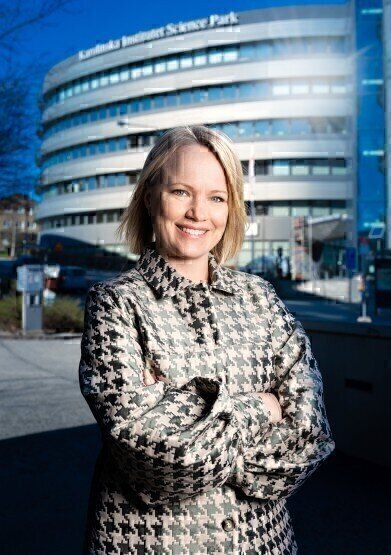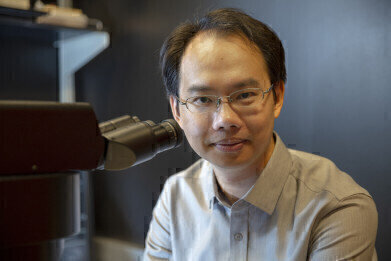-
 Dr George Patterson
Dr George Patterson -
 Emma Lundberg
Emma Lundberg -
 Wei Min
Wei Min -
.jpg)
News
RMS proudly announce Scientific Achievement Award winners for 2021
Oct 19 2021
Open to microscopists from across the globe, the Award aims to celebrate outstanding scientific achievements in any area of microscopy or flow cytometry for established, mid-career researchers. The latest winners presented talks at the recent RMS Microscopy: Advances, Innovation, Impact 2021 Meeting, which incorporated the RMS AGM and Section AGMs. Held on 14 October 2021, talks were also given by new Honorary Fellows: Professor Peter Nellist, Hon FRMS and Professor George D W Smith, Hon FRMS.
The RMS 2021 Scientific Achievement Award winners are:
Professor Marisa Martin-Fernandez
Central Laser Facility, Research Complex at Harwell (RCaH). Group leader, Octopus Imaging facility
Marisa is an exceptional interdisciplinary scientist who has taken advantage of her physics background to deliver ground-breaking research in the life sciences.
Her innovative technique developments, together with her enthusiasm for sharing these with the research community, has ensured that her work has had an impact far beyond her own research area. Over the last 20 years Marisa has developed pioneering single molecule fluorescence microscopy methods for the characterisation of molecular structure of membrane receptor complexes in mammalian cells.
RMS President Professor Grace Burke said: “It is a privilege to recognise Marisa’s achievements with this award. Her impact on bio-imaging and her multi-disciplinary approach have delivered new capabilities to the UK-wide community – not least through the exceptional facility she has developed at RCaH. The infectious enthusiasm and energy with which she goes about her work will no doubt continue to serve both her, and the wider microscopy community well for years to come.”
Professor Emma Lundberg
Science for Life Laboratory, KTH Royal Institute of Technology, Stockholm, Sweden.
Emma is an extraordinary investigator who elegantly combines different fields ranging from proteomics to image analysis, computer science and microscopy. Her work has gathered international attention.
She has been the driving force behind the creation of the Cell Atlas - an open-access project sharing microscopic images of protein patterns, making proteomics a microscopy discipline. It is part of the Swedish Human Protein Atlas (HPA) programme. Recent work includes a single cell proteogenomic map of the cell cycle, where they discovered over 300 novel cell cycle proteins.
RMS President Professor Grace Burke noted: “Emma is clearly an inspiration to others, and represents a new type of scientist and role model. In both her research activities and her outreach work, she has demonstrated the sort of pioneering qualities and innovative thinking that have always driven the best scientific advances. She is a truly worthy recipient of this award.”
Professor Wei Min
Department of Chemistry, Columbia University, USA
Professor Wei Min is an outstanding scientist and spectroscopist now focused primarily on novel approaches to microscopy and imaging. He has pioneered a series of revolutionary advances both in the development and applications of molecular vibrational imaging.
Having graduated from Peking University in 2003, Wei received his PhD from Harvard University in 2008 with Professor Sunney Xie. After continuing a postdoctoral in the Xie group, he joined the Faculty of Chemistry Department at Columbia University in 2010, and was promoted to Full Professor in 2017. He is also affiliated with Department of Biomedical Engineering, Kavli Institute for Brain Science, and NeuroTechnology Center at Columbia.
RMS President Professor Grace Burke remarked: “For many years now, Wei has demonstrated his enormous skill as an experimentalist and microscopist. His vision to develop new imaging approaches that can impact our understanding of complex biological systems has opened up tremendous possibilities in the Life Sciences field, and he is both an obvious and fully deserving candidate for this award.”
Dr George Patterson (1970 – 2021)
National Institute of Biomedical Imaging and Bioengineering at NIH, USA
Earlier this year, our first recipient of the RMS Scientific Achievement Award was announced as Dr George Patterson, of the National Institute of Biomedical Imaging and Bioengineering at NIH. Very sadly, George passed away shortly after learning about the award, at just 50 years of age.
RMS President Grace Burke spoke on behalf of the Society: “We were so sad to hear the news about George, who was taken away far too soon. George was a brilliant scientist and we are very proud to have included him amongst our award-winners this year. His passing has left a huge void in the scientific community, and our thoughts remain with his young family, friends and colleagues.”
George’s ground-breaking research focused on developing tools for applications to cell biology, including the development of probes, technical applications and software. Among his most notable achievements was his development of photoactivatable green fluorescent protein, while working at Jennifer Lippincott-Schwartz’s lab. He made essential contributions to the super-resolution technique, photoactivated localisation microscopy (PALM, Betzig et. al., Science, 2006), which later won a share of the 2014 Nobel Prize in Chemistry.
Further details about the Royal Microscopical awards, events and activities, can be found on the link below.
More information online
Digital Edition
Lab Asia Dec 2025
December 2025
Chromatography Articles- Cutting-edge sample preparation tools help laboratories to stay ahead of the curveMass Spectrometry & Spectroscopy Articles- Unlocking the complexity of metabolomics: Pushi...
View all digital editions
Events
Jan 21 2026 Tokyo, Japan
Jan 28 2026 Tokyo, Japan
Jan 29 2026 New Delhi, India
Feb 07 2026 Boston, MA, USA
Asia Pharma Expo/Asia Lab Expo
Feb 12 2026 Dhaka, Bangladesh


















